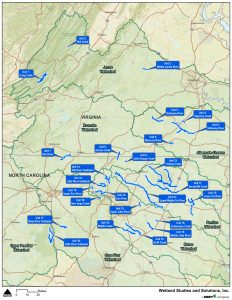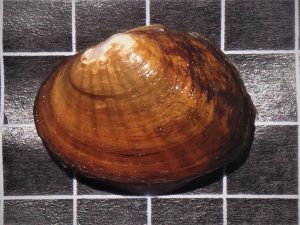Atlantic Pigtoe Proposed Listed as Threatened, May Impact Future VA and NC Projects
On September 22, 2020, the U.S. Fish and Wildlife Service (USFWS) announced a 30-day reopening of the comment period for the Atlantic pigtoe mussel (Fusconia masoni) for listing as federally threatened under the Endangered Species Act. If the Atlantic pigtoe is listed, all projects across the named central Virginia and North Carolina river basins requiring federal agency consult – such as wetland permits, FEMA approvals, or federally-funded road projects – will have to address the species and its critical habitat. The listing was first proposed in October 2018, however since that time, the USFWS has prepared a 4(d) rule and proposed critical habitat for the mussel. The comment period closes October 22, 2020.
Critical Habitat

Critical habitat if Atlantic pigtoe is listed under the Endangered Species Act
The USFWS is proposing critical habitat in multiple river basins in Virginia and North Carolina: Craig Creek, Mill Creek, James River, Sappony Creek, Nottoway River, Meherrin River, Dan River, Aarons Creek, Little Grassy Creek, Tar River, Sandy/Swift Creek, Fishing Creek, Neuse, New Hope Creek, Deep River, and Little River. Expressly defined in the Endangered Species Act, critical habitat describes specific geographic areas that are determined to be essential to the survival of a species that has been listed as threatened or endangered under the Section 4 of the Endangered Species Act. These areas may require special management considerations or protection (e.g., certain activities may be restricted from occurring in these areas).
4(d) Rule Exceptions
The proposed 4(d) rule provides for a few exceptions where incidental take of the mussel may be allowed, including species restoration efforts, channel (i.e., stream) restoration projects, bank stabilization projects, and silvicultural activities. For silvicultural exemptions, tree harvest is not allowed within 50 feet of the stream (a primary management zone) and the buffer can be extended based on the surrounding slope (a secondary management zone).
What Does This Mean for My Projects?

Atlantic pigtoe (Fusconia masoni)
Any projects within the designated units requiring federal agencies to consult with the USFWS under Section 7 of the Endangered Species Act will have to address this species and the critical habitat. Examples of such actions would be wetlands permits, FEMA approvals, or projects with federal funding, such as roads.
Threats to the Atlantic pigtoe within the critical habitat units vary and include excess sediments from stormwater runoff, high E. coli levels, excessive nitrogen and phosphorus inputs, low pH, low dissolved oxygen, and point source discharges of wastewater. Projects with disturbance within these units may be required to show how they address unit-specific threats.
WSSI Can Help
Wetland Studies and Solutions, Inc. is very experienced in dealing with potential mussel habitat on project sites and can help plan your project to avoid impacting the species. We also work very closely with USFWS-approved mussel surveyors to coordinate a survey when required. Please contact Ben Rosner in our Gainesville office for more information or to discuss how this may impact your project.
